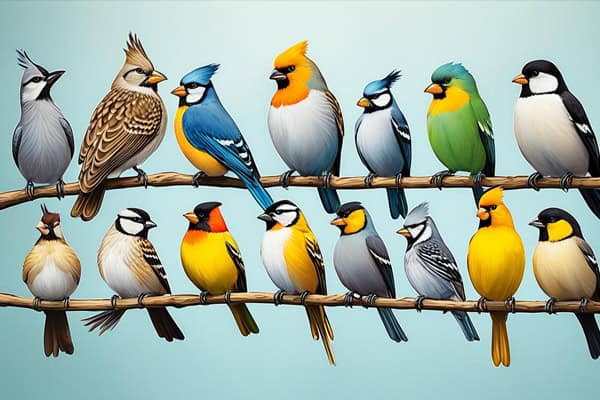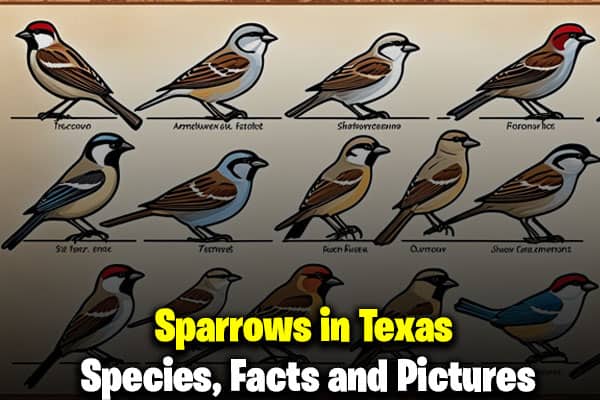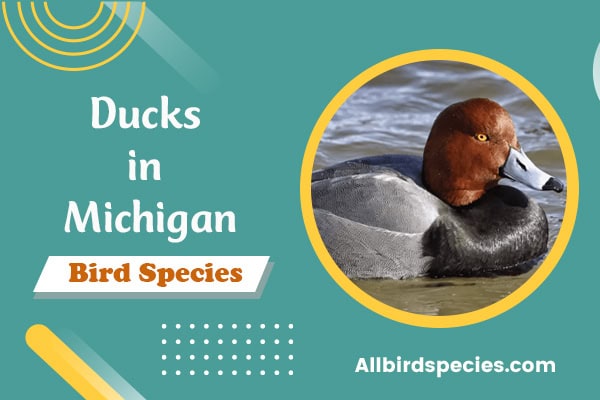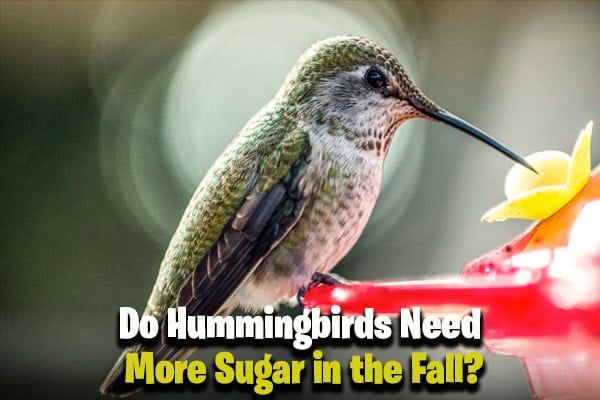Hummingbirds in Georgia (11 Species With Photos)
Did you know Georgia has over 11 types of hummingbirds? These birds are not just a treat for our eyes. They also help pollinate plants, which is key to our ecosystem’s health. This article will take you into the world of hummingbirds in Georgia. We’ll look at their unique traits, how they live, and why we need to protect them.
We’ll focus on the Ruby-throated Hummingbird and share tips for birdwatching. Also, We’ll talk about how these birds make our world more beautiful. Let’s dive into the beauty of hummingbirds and see how we can help them thrive for years to come.
1. Ruby-throated hummingbird
- Scientific name: Archilochus colubris
- Life span: 3-5 years
- Size: 3-3.75 in
- Weight: 2-6 g
- Wingspan: 3.1-4.3 in
The Ruby-throated Hummingbird, known as Archilochus colubris, is a sight to behold. Its stunning looks and interesting behaviors capture our attention. The bird’s bright ruby throat in males is a key feature that stands out in nature.

Habitat and Behavior
These hummingbirds are often seen in gardens, woodlands, and places with lots of flowers. They move quickly from flower to flower, using their long beaks to get nectar. They also eat insects and spiders, which give them the protein they need.
The way they build their nests is quite interesting. The female makes the nest from plant fibers and spider silk. She puts it on a thin branch. This makes the nest safe and hard to see, helping the eggs and chicks survive.
| Characteristic | Details |
|---|---|
| Scientific Name | Archilochus colubris |
| Physical Traits | Male: Ruby throat, emerald green back, white underparts |
| Size | 3 to 4 inches |
| Weight | 2 to 6 grams |
| Wingspan | 3.1 to 4.3 inches |
| Diet | Nectar, insects, and spiders |
| Nesting | Built with plant fibers and spider silk |
| Life Expectancy | 3 to 5 years |
2. Black-Chinned Hummingbird
- Scientific name: Archilochus alexandri
- Life span: 3-6 years
- Size: 3-4 in
- Weight: 2.5-4.5 g
- Wingspan: 4.3-5.1 in
To truly appreciate the beauty of the Black-Chinned Hummingbird, we must explore its unique features and behaviors. This small bird is a key part of our ecological world. It has special physical traits that help us identify it and nesting habits that show its cleverness.
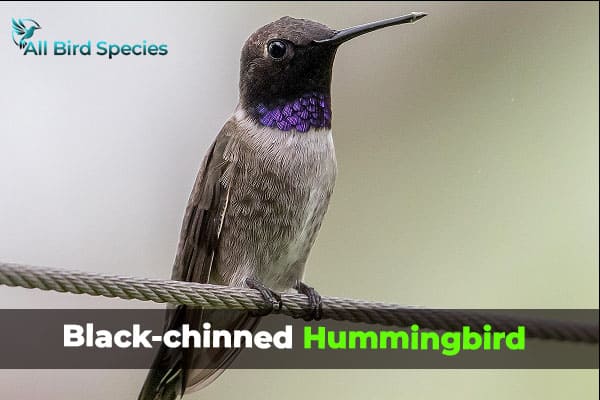
Identification Features
The Black-Chinned Hummingbird (Archilochus alexandri) has an elegant look. Males have a striking black throat with a hint of iridescent purple. This contrasts with their muted green upperparts. Females look softer with grayish-white underparts.
These birds are about 3 to 4 inches long and weigh between 2.5 to 4.5 grams. Their bright colors and small size make them easy to spot during their busy flights.
Nesting Habits
The Black-Onned Hummingbird has a unique way of building nests. They prefer natural spots and use plant down, spider silk, and other local materials. Their nests are cup-shaped and hang from tree branches, showing off their skill.
Every year, they often rebuild their nests. This shows their dedication to creativity and survival.
| Feature | Male | Female |
|---|---|---|
| Throat Color | Black with Iridescent Purple | Grayish-White |
| Upperparts | Muted Green | Muted Green |
| Length | 3 to 4 inches | 3 to 4 inches |
| Weight | 2.5 to 4.5 grams | 2.5 to 4.5 grams |
3. Calliope Hummingbird
- Scientific name: Selasphorus calliope
- Life span: 3-7 years
- Size: 2.75-3.25 in
- Weight: 2-4 g
- Wingspan: 3.5-4.3 in
The Calliope Hummingbird is the smallest Hummingbird in North America. It’s known as the Selasphorus calliope. Learning about its size and what it eats helps us love these tiny birds more.

Physical Description
This bird is tiny, measuring 2.75 to 3.25 inches long and weighing 2 to 4 grams. The males have bright magenta stripes on their throats. They look amazing.
The females are less flashy, with green on top and white below. This helps them hide in the trees.
Feeding Habits
Calliope Hummingbirds love to drink nectar. It gives them the energy they need to fly so much. They also eat small bugs to get protein.
This is important for their survival, especially when they’re fighting for territory or finding a mate.
4. Rufous Hummingbird
- Scientific name: Selasphorus rufus
- Life span: 3-5 years
- Size: 2.75-3.75 in
- Weight: 2.5-4.5 g
- Wingspan: 3.5-4.3 in
The Rufous Hummingbirds of Georgia is a standout in North America. Its unique traits make it easy to spot. This bird grabs the interest of bird lovers and those just passing by. Learning about its features helps us appreciate these birds more.

Distinctive Traits
Males of the Rufous Hummingbird (Selasphorus rufus) stand out with their bright orange-red feathers. This color helps them stand out and attract mates in the spring. Females, on the other hand, have green feathers with speckled throats. This helps them hide in the trees.
These birds are small, measuring 2.75 to 3.75 inches long. They have the same wingspan, making them quick and nimble in the air. They live from the Pacific Northwest to central Mexico. This lets us see their unique traits in different places.
5. Rivoli’s Hummingbird
- Scientific name: Eugenes fulgens
- Life span: 8-12 years
- Size: 4.3-5.5 in
- Weight: 7-9 g
- Wingspan: 7.5-9 in
Rivoli’s Hummingbird (Eugenes fulgens), also known as the Magnificent Hummingbird, is a bird that catches our eye. It has striking looks and lives in special places. Learning about it helps us appreciate its place in nature.
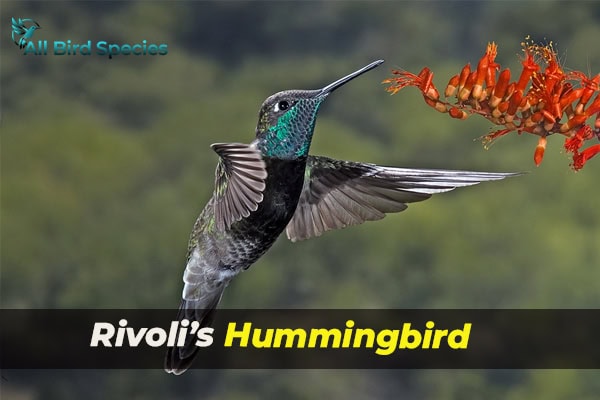
Size and Appearance
This bird is between 4.3 and 5.5 inches long and weighs 7 to 9 grams. The males stand out with their emerald green back and deep blue violet throat. These features make them easy to spot.
The females are less flashy but still shine with some sparkle. Rivoli’s Hummingbird is a stunning sight to see.
Geographical Range
Rivoli’s Hummingbird lives in the southwestern United States and Central America. It loves the mountains and forests. Bird lovers in Georgia might see it during its migrations.
| Characteristic | Details |
|---|---|
| Size | 4.3 to 5.5 inches |
| Weight | 7 to 9 grams |
| Male Appearance | Iridescent emerald green back, deep blue-violet throat |
| Female Appearance | Subdued color palette with shimmering characteristics |
| Habitat | Mountainous woodlands |
| Geographical Distribution | Southwestern United States to Central America |
| Migration | Seasonal visitor in Georgia |
Other Rare Hummingbirds in Georgia
Georgia is home to many common hummingbirds, but the Allen’s Hummingbird and the Broad-Billed Hummingbird are rare visitors. These birds are exciting for birdwatchers because they are not often seen. Identifying them is a fun challenge.
6. Allen’s Hummingbird
- Scientific name: Selasphorus sasin
- Life span: 5-8 years
- Size: 3-3.75 in
- Weight: 2-4 g
- Wingspan: 3.5-4 in
The Allen’s Hummingbirds of Georgia (Selasphorus sasin) stands out with its bright orange underparts and tail. Its green upperparts and vibrant red-orange throat make it easy to spot. This bird usually lives in coastal California but sometimes visits Georgia during its migration.
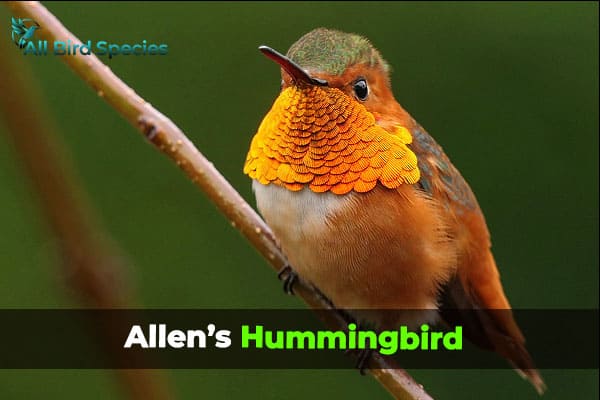
7. Broad-Billed Hummingbird
- Scientific name: Cynanthus latirostris
- Life span: 5-7 years
- Size: 3.5-4.3 in
- Weight: 3-5 g
- Wingspan: 4.7-5.5 in

The Broad-Billed Hummingbird (Cyanthus latirostris) is a rare sight in Georgia. It has green feathers on top and a beautiful violet-blue throat. This bird lives mainly in southwestern Arizona and Mexico. Seeing it in Georgia is a treat, especially when it visits feeders during migration.
| Species | Identification Features | Typical Range | Notable Characteristics |
|---|---|---|---|
| Allen’s Hummingbird | Orange underparts, green upperparts, red-orange throat (males) | Coastal California, occasional sightings in Georgia | Rare in Georgia, migratory behavior |
| Broad-Billed Hummingbird | Green upperparts, violet-blue throat | Southwestern Arizona, rarely in Georgia | Visits feeders during migration, vibrant coloration |
8. Mexican Violetear
- Scientific name: Colibri thalassinus
- Life span: 5-7 years
- Size: 3.5-4.3 in
- Weight: 6-8 g
- Wingspan: 4.7-5.5 in
The Mexican Violetear, a striking hummingbird native to Central America and Mexico, sometimes ventures into the southern United States. This species is celebrated for its vibrant violet ear patches that contrast vividly with its rich green plumage.
The bird’s deep green feathers extend from its crown to its tail, with the violet patches providing a stunning and distinctive highlight.
Mexican Violetears are true artisans among birds, crafting nests that are both functional and aesthetically pleasing. The females build small, cup-shaped nests in trees or shrubs, weaving together plant fibers and spider webs.
Often adorned with bits of bark and lichen for camouflage, these nests blend effortlessly into their surroundings. This meticulous nest-building reflects the bird’s natural instincts and commitment to safeguarding their offspring.
9. Green-breasted Mango
- Scientific name: Anthracothorax prevostii
- Life span: 6-10 years
- Size: 4-4.5 in
- Weight: 5-8 g
- Wingspan: 6-6.5 in
The Green-breasted Mango, a dazzling tropical hummingbird, ranges from Mexico through Central America to northern South America. Its distinctive iridescent green plumage is complemented by a black central stripe running down its underparts.
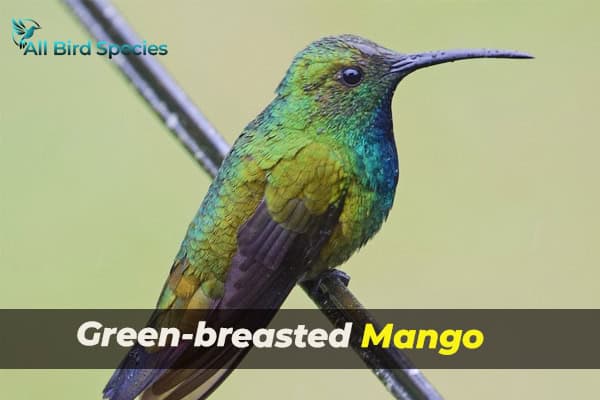
Males display a vivid blue throat, while females have a more understated white throat with black edges. Their sleek, streamlined bodies and long, forked tails enhance their elegant appearance, making them a striking presence in their lush tropical habitats.
Green-breasted Mangos are masterful nest builders, creating nests that showcase nature’s craftsmanship. Females weave their nests in trees or shrubs using a blend of plant materials and spider silk.
Camouflaged with bits of vegetation, these nests seamlessly blend into their surroundings. This meticulous nest-building reflects the bird’s profound connection to their environment and their instinct to safeguard their young.
Flowers That Attract Hummingbirds
Flowers that attract hummingbirds are typically vibrant, tubular, and rich in nectar, offering a visual and aromatic invitation to these agile pollinators. Species such as trumpet creepers, bee balm, and salvias are particularly appealing due to their bright, intense colors—especially reds, oranges, and pinks—which stand out against green foliage and catch the attention of hummingbirds from afar. The structure of these flowers, with their deep, tubular shapes, is perfectly suited to accommodate the long, slender bills of hummingbirds, allowing them to access the nectar while simultaneously facilitating effective pollination.
Check Our Previous Articles:
FAQ’s
Q1. What months are hummingbirds in Georgia?
Mid-March to early November.
Q2. Do hummingbirds live in Georgia?
Yes, they do, especially during migration.
Q3. Which US state has the most hummingbirds?
Arizona.
Q4. Do hummingbird moths live in Georgia?
Yes, they do.
Q5. Where do hummingbirds nest?
In trees, shrubs, or sometimes in sheltered spots like eaves or hanging baskets.


